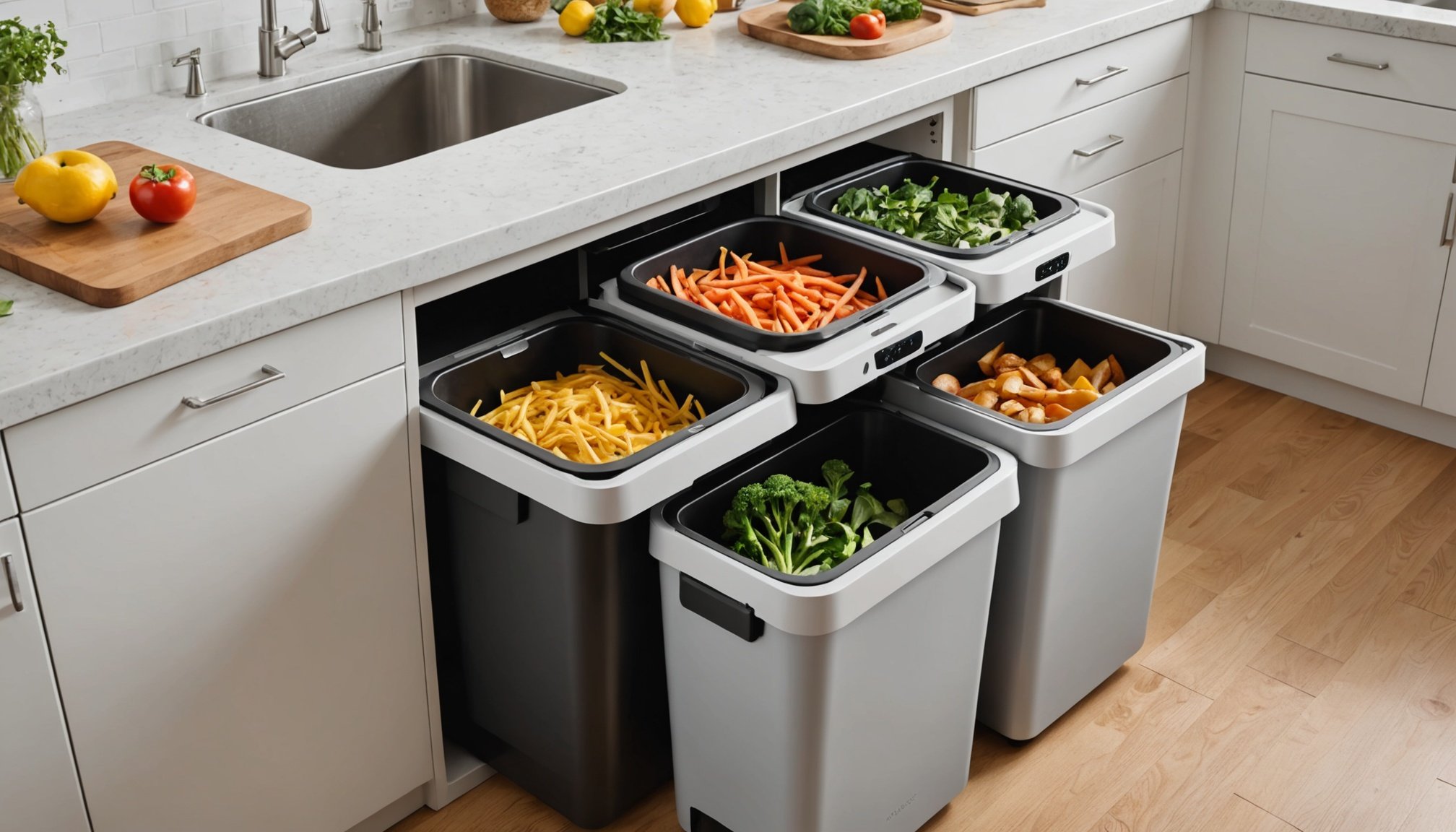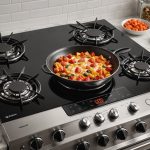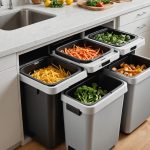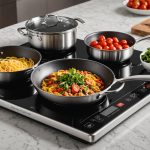Transform Your Kitchen: Foster Healthier Eating with an Innovative Smart Waste Sorting System
In the heart of every home, the kitchen is more than just a place for cooking; it’s a hub of activity, creativity, and sustainability. One of the most significant steps you can take to make your kitchen more eco-friendly and efficient is to implement a smart waste sorting system. This article will delve into the world of innovative waste management, exploring how these systems can transform your kitchen, reduce waste, and foster healthier eating habits.
The Importance of Smart Waste Management in Your Kitchen
Smart waste management is not just about disposing of trash; it’s about creating a sustainable and efficient system that benefits both your home and the environment. Here are a few reasons why integrating a smart waste sorting system into your kitchen is crucial:
Also read : Selecting the Perfect Lean Kitchen Sink: Simplify Cleanup and Curb Food Temptations
Reducing Waste and Promoting Sustainability
Smart waste sorting systems help in segregating different types of waste, such as food waste, recyclables, and general trash. This segregation is key to reducing the amount of waste that ends up in landfills and promoting a circular economy. For instance, the Totem Max 60L Stainless-steel Waste & Recycling Bin features separate compartments for general waste, recycling, and food waste, making it easier to manage and reduce waste effectively[1].
Enhancing Kitchen Hygiene
A well-organized waste management system keeps your kitchen cleaner and fresher. Integrated odour control features, like those in the Totem Max bin, use activated carbon filters to minimize unpleasant smells, ensuring your kitchen remains a pleasant space for cooking and meal planning[1].
Topic to read : Ultimate Guide to Compact Vertical Freezers: Maximize Storage for Your Prepped Diet Meals
Supporting Healthier Eating Habits
By managing food waste efficiently, you can gain insights into your eating habits and make more informed choices. For example, if you notice you’re frequently disposing of certain food items, it might be a sign to adjust your meal planning to reduce food waste.
Innovative Appliances for Smart Waste Sorting
The market is filled with innovative appliances designed to make waste sorting smarter and more efficient. Here are a few standout examples:
Totem Max 60L Stainless-steel Waste & Recycling Bin
- Multi-compartment Design: This bin includes two 30-litre compartments for general waste and recycling, along with a 3-litre removable food waste caddy.
- Integrated Odour Control: Uses replaceable activated carbon filters to keep the kitchen smelling fresh.
- Space-Saving Design: The vertical layout maximizes capacity in a compact space[1].
Vego Composter
- Quick Composting: Transforms food waste into nutrient-rich compost in under 24 hours.
- Advanced Odour Control: Uses activated carbon filters and VegoTabs to enhance the composting process and minimize odors.
- Smart Technology: Includes Bluetooth and Wi-Fi connectivity for real-time monitoring through the Vego App[2].
hOmeLabs 13 Gallon Touchless Trash Can
- Touchless Operation: Features an infrared motion sensor that opens the lid with a simple hand wave.
- Adjustable Sensor: Allows for flexible positioning to detect motion from the top or side.
- Power Options: Can be powered by batteries or an AC adapter[3].
How Smart Waste Sorting Systems Work
Smart waste sorting systems often incorporate advanced technology to make the process efficient and user-friendly. Here’s a detailed look at how some of these systems work:
Automated Composting
The Vego Composter is a prime example of automated composting. It uses low-temperature processing to preserve beneficial microbes, an intelligent scale to adjust processing times based on the weight of the scraps, and a smart app for real-time monitoring. This ensures that food waste is transformed into nutrient-rich compost quickly and efficiently[2].
Sensor-Activated Waste Bins
The hOmeLabs 13 Gallon Touchless Trash Can uses an infrared motion sensor to open the lid, making it easy to dispose of waste without touching the bin. This feature is particularly useful in kitchens where hygiene is paramount[3].
Practical Insights and Actionable Advice
Implementing a smart waste sorting system is just the first step; here are some practical insights and actionable advice to help you make the most out of your new system:
Start Small
Begin with a simple compost bin like the Joseph Joseph Compo 4 Easy-Fill Compost Bin or the EPICA Countertop Compost Bin. These bins are easy to use, convenient to transport, and sized to fit your family’s needs[4].
Use the Right Tools
Invest in compost bins with integrated odour control features. For example, the Chef’n EcoCrock Counter Compost Bin uses a charcoal filter to keep odors at bay, making it perfect for countertop use[4].
Monitor and Adjust
Use data from your smart waste sorting system to monitor your waste output. For instance, the Vego Composter’s app provides real-time updates, helping you adjust your meal planning and reduce food waste effectively[2].
Benefits of a Smart Waste Sorting System
A smart waste sorting system offers numerous benefits that extend beyond just waste management:
Environmental Impact
By reducing the amount of waste sent to landfills, you contribute to a more sustainable environment. Composting food waste, for example, reduces greenhouse gas emissions and helps in creating nutrient-rich soil amendments[2][4].
Cost Savings
Efficient waste management can save you money in the long run. For instance, composting reduces the need for synthetic fertilizers, and recycling can lower your waste disposal costs.
Healthier Cooking
A well-managed kitchen waste system encourages healthier cooking habits. By reducing food waste, you’re more likely to plan meals carefully, use up leftovers, and incorporate more fruits and vegetables into your diet.
Comparing Smart Waste Sorting Systems
Here is a comparative table of some of the innovative smart waste sorting systems mentioned earlier:
| Product | Key Features | Capacity | Odour Control | Smart Technology | Price |
|---|---|---|---|---|---|
| Totem Max 60L | Multi-compartment design, integrated odour control | 60L (2x30L + 3L food waste caddy) | Activated carbon filters | No | Around $200 |
| Vego Composter | Automated composting, Bluetooth/Wi-Fi connectivity | 4L (compost capacity: 3.3Lb) | Activated carbon filters & VegoTabs | Yes | Around $600 |
| hOmeLabs 13 Gallon Touchless Trash Can | Touchless operation, adjustable sensor | 13 Gallons | No integrated odour control | No | Around $100 |
Real-Life Examples and Testimonials
Here are some real-life examples and testimonials that highlight the effectiveness of these systems:
Vego Composter User
“The Vego Composter has been a game-changer for my kitchen. It’s so easy to use and the compost it produces is amazing for my garden. The odour control is fantastic, and the app keeps me updated on the composting process,” says a satisfied user[2].
Totem Max 60L User
“I was skeptical about using a multi-compartment bin, but the Totem Max has made waste sorting so much easier. The integrated odour control keeps my kitchen smelling fresh, and the design is both stylish and functional,” notes another user[1].
Transforming your kitchen with a smart waste sorting system is a step towards a more sustainable, efficient, and healthier cooking environment. By choosing the right appliances and tools, you can significantly reduce waste, promote sustainability, and foster healthier eating habits.
As one user aptly put it, “Investing in a smart waste sorting system is not just about managing waste; it’s about creating a healthier, more sustainable home.”
Additional Tips for a Zero Waste Kitchen
Here are some additional tips to help you achieve a zero waste kitchen:
- Meal Planning: Plan your meals carefully to avoid buying too much food that might go to waste.
- Use Up Leftovers: Be creative with leftovers to reduce food waste.
- Compost: Compost food waste to create nutrient-rich soil amendments.
- Recycle: Ensure you recycle as much as possible, including paper, plastic, and glass.
- Avoid Single-Use Items: Opt for reusable bags, containers, and water bottles.
By combining these tips with a smart waste sorting system, you can create a kitchen that is not only efficient but also eco-friendly and sustainable.
In conclusion, a smart waste sorting system is more than just an appliance; it’s a tool for creating a healthier, more sustainable kitchen. With the right technology and a bit of planning, you can reduce waste, promote sustainability, and enjoy the benefits of a well-managed kitchen. So why wait? Transform your kitchen today and start your journey towards a more eco-friendly and efficient home.











